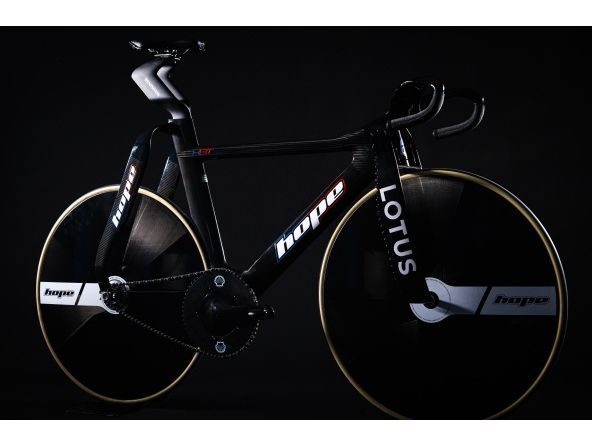Categories more
- Adventures (17)
- Arts / Collectables (15)
- Automotive (37)
- Aviation (11)
- Bath, Body, & Health (77)
- Children (6)
- Cigars / Spirits (32)
- Cuisine (16)
- Design/Architecture (22)
- Electronics (13)
- Entertainment (4)
- Event Planning (5)
- Fashion (46)
- Finance (9)
- Gifts / Misc (6)
- Home Decor (45)
- Jewelry (41)
- Pets (3)
- Philanthropy (1)
- Real Estate (16)
- Services (23)
- Sports / Golf (14)
- Vacation / Travel (60)
- Watches / Pens (15)
- Wines / Vines (24)
- Yachting / Boating (17)
Published
08/03/2023 by LotusThe second-generation Hope-Lotus track bike, unveiled today, has been meticulously designed and optimised to deliver improved track performance at the 2024 Olympic Games in Paris.
Lotus Engineering has collaborated with the Great Britain Cycling Team (GBCT), Hope Technology and Renishaw to evolve the Tokyo 2020 track bike which contributed to the track team winning seven Olympic medals and topping the event medal table.
Lotus and GBCT have developed the cockpit of the bike, evolving the unique front fork and handlebar design to allow for greater aerodynamic efficiency. This is coupled with the Hope HBT Paris frame which includes refinements to the headstock and seat stays. Renishaw has provided support in design and production of wind tunnel models and other crucial components on the final bike.
GBCT has been testing the bike rigorously on track and in a wind tunnel, working alongside the Lotus team to optimise the forks and handlebars ahead of its competitive track debut next month at the 2023 UCI Cycling World Championships in Glasgow, Scotland.
Richard Hill, Chief Aerodynamicist at Lotus, was responsible for the design of the Lotus 108 Olympic track bike and 110 Tour De France bike in the nineties and has continued to play a pivotal role in both the Tokyo Olympic track bike and now, the 2024 Hope-Lotus Olympic track bike.
Lotus Engineering has played to its strengths of optimised aerodynamics, advanced materials, lightweighting and engineering innovation to help guide the bike’s cockpit development. It has applied learnings made over 75 years in vehicle dynamics to improve front-end feel and stiffness to enhance rider confidence. Additional evolution of the components creates the sensation that the bike is carving through air, a signature element of the aerodynamic design found in the new Lotus vehicle line-up.
The unique patented, wide element fork design, introduced at the Tokyo Olympic Games, continues to reduce drag and break the air flow in front of the rider. Taking inspiration from fighter jet design, the fork has a new serrated edge that allows for smoother airflow around the rider. Customisable handlebars help riders to achieve a more efficient aero position for longer races, whilst an enhanced integration with the fork further reduces drag.
To guarantee lightness, the composite fork is crafted from the same high-grade carbon fibre and single-cure manufacturing process as the Lotus Evija hypercar. A combination of carbon fibre and 3D-printed metals is used to optimise aerodynamics, ergonomics, structural integrity and lightweighting.
More than 150 hours of wind tunnel testing and advanced computational fluid dynamics (CFD) simulation has helped to create significant aerodynamic gains. This testing was instrumental in optimising the airflow around the legs of the rider to reduce drag.
Mark Stringer, Commercial Director, Lotus Engineering said:
“Lotus is proud to have again played its part in helping British Cycling push the boundaries of sporting performance in the quest for Olympic medals. It’s the perfect demonstration of our ability to transfer the skills and knowledge we’ve gained through 75 years of automotive development to bring a new perspective to other industries. Through the deployment of our expertise, innovation, tools, techniques and processes developed to engineer high-performance Lotus cars, we’ve been able to deliver efficiencies to give British track riders the best possible opportunity for success.”
Lotus has a successful history in cycling through its Lotus Engineering division. Innovations include the early Lotus sports bikes used by cycling legend Chris Boardman in the nineties, the iconic Lotus type 108 in the noughties, through to the Hope-Lotus collaborations.
Stephen Park CBE, Performance Director for the Great Britain Cycling Team, said:
“Our relationship with Lotus Engineering, Hope Technology and Renishaw is going from strength to strength. Their combined high quality manufacturing standards, renowned lightweight design, aerodynamic efficiency and their keen eye for finer details help us to unlock valuable marginal gains, which make all the difference come race day. This is the most advanced bike that has ever been ridden by British athletes.”















